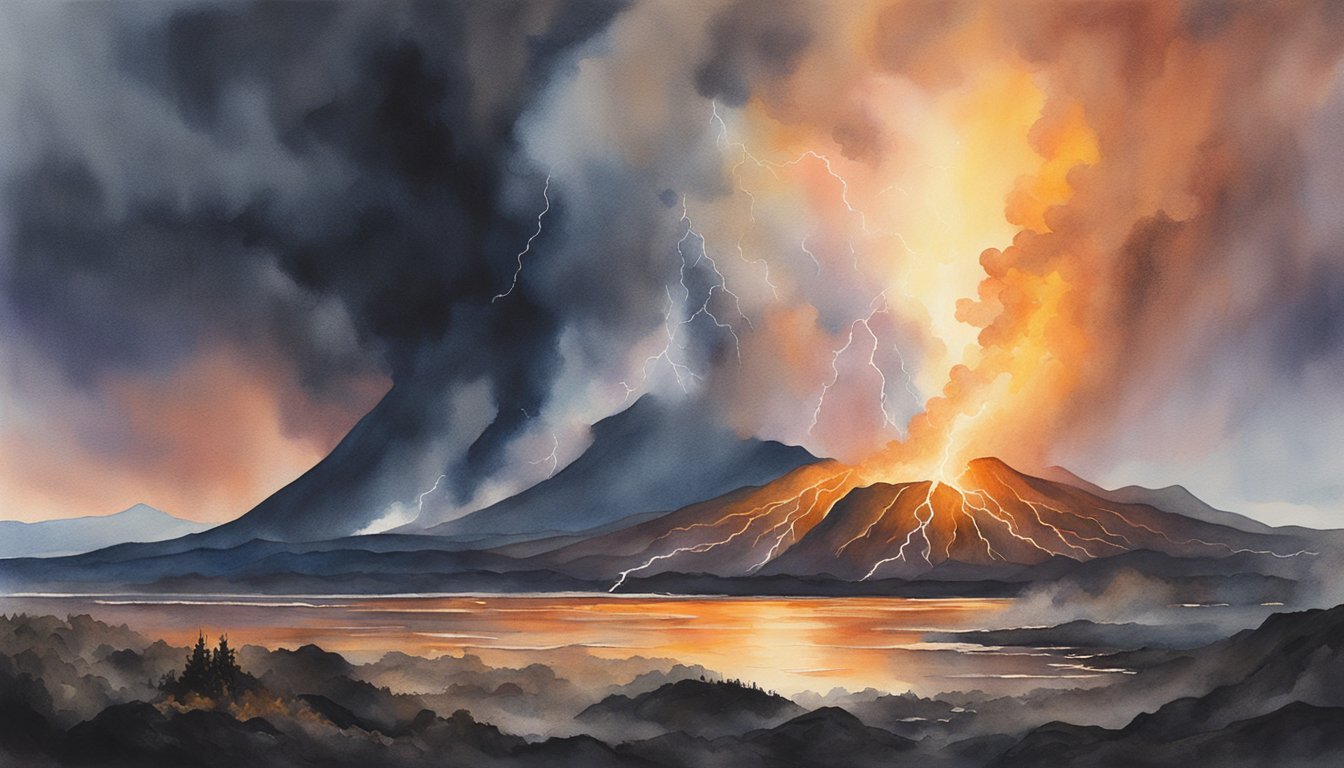Understanding Volcanic Lightning
Phenomenon Overview
Volcanic lightning is a unique and visually captivating natural phenomenon that occurs during a volcanic eruption. It is the result of an electrical discharge caused in the plume of a volcanic eruption. This form of lightning takes place when particles of volcanic ash and sometimes ice collide and generate static electricity within the volcanic plume, leading to what is sometimes referred to as a dirty thunderstorm.
Geological Conditions
Several factors work together to create the right conditions for volcanic lightning to occur. One major factor is the vent of the erupting volcano. The vent allows magma and gases to escape, sending ash and rock fragments into the air. The interaction between the magma, ash particles, and the surrounding atmosphere inside and around the volcanic plume creates a complex interplay of charged particles.
Another key ingredient is the ambient temperature in the area. Cool temperatures can contribute to the formation of ice inside the volcanic plume, which enhances the potential for electrical discharges. As the ash plume reaches higher altitudes, the surrounding air becomes colder, and ice formation becomes more likely. This further increases the chances of volcanic lightning.
Types of Volcanic Lightning
There are different types of volcanic lightning based on the various mechanisms that can lead to the build-up of electric charge within the volcanic plume. Four of the main mechanisms are ice formation, ash particle collisions, fragmented rock, and ambient atmospheric conditions. These mechanisms occur at different heights of the ash plume and are influenced by the temperature and water sources near the volcano.
In addition to the primary volcanic lightning mechanisms, researchers have also been exploring the use of infrasound data to better understand and predict volcanic activity. Infrasound is low-frequency sound that can be produced during a volcanic eruption and is sometimes associated with volcanic lightning. Studying this data can provide valuable insights that may help scientists better comprehend the complex interactions and dynamics of volcanic lightning, and in turn, improve eruption forecasting and public safety.
In conclusion, volcanic lightning is a fascinating and complex phenomenon that occurs during volcanic eruptions. Various factors and geological conditions contribute to the formation of this awe-inspiring natural display, and researchers continue to study it to better understand the dynamics and mechanisms behind it.
Impacts and Observations

Environmental and Climate Relevance
Volcanic lightning can have a significant impact on the environment and climate. When a volcanic eruption occurs, ash plumes are generated, and these can lead to the formation of storms and thunderstorms in the atmosphere. The Calbuco volcano in Chile is one example of an eruption that produced a significant ash plume and subsequent thunderstorms. A combination of electrification, static electricity, and friction within ash plumes can create a “dirty thunderstorm,” resulting in volcanic lightning. Charge generation during volcanic eruptions can be attributed to processes like fractoemission, frictional charging, and radioactive charging, all of which are detailed in a Surveys in Geophysics study.
Volcanic lightning has the potential to alter the concentrations of ions and electrons in the atmosphere. For instance, the Eyjafjallajökull eruption in Iceland displayed a significant increase in cloud-to-ground lightning. When ash plumes interact with ice particles from glaciers or lakes in the vicinity of an eruption, ice charging occurs, intensifying the electrical activity. This is well-documented in the eruptions of Sakurajima volcano in Japan and Grímsvötn in Iceland.
Volcano Monitoring and Safety
Volcanic lightning offers valuable information for volcano monitoring and safety. Detecting lightning activity during an eruption can help scientists determine the size and intensity of the event. In some cases, lightning can indicate changes in eruption dynamics, providing crucial information for emergency management and aviation safety. For example, the Alaska’s Pavlof volcano eruption in 2016 demonstrated the importance of tracking plume lightning to predict the consequences of ash dispersion.
Geophysical monitoring techniques have evolved to capture electromagnetic data related to volcanic lightning. The World Wide Lightning Location Network (WWLLN) is one such system that tracks lightning activity around the globe. WWLLN data, along with other observations, aids in understanding the relationship between thunderstorm electrification and volcanic activity.
Historical Accounts and Research
Volcanic lightning has been documented throughout history, providing vital information for researchers. Mount Vesuvius, the infamous volcano that destroyed Pompeii, was observed by Pliny the Younger, who described the lightning activity during the eruption. Similarly, the Vesuvius Observatory contains records of volcanic lightning events at Mount Etna in Sicily.
More recently, scientific studies have focused on analyzing a variety of phenomena associated with volcanic lightning. Examples include the creation of volcanic hail, the formation of fulgurites, and the presence of volcanic spherules. Lightning-induced volcanic spherules, for instance, are the product of extremely high temperatures during lightning strikes, leading to the vaporization of volcanic ash and subsequent formation of small glassy beads. Researchers have studied such occurrences in various journals, such as the Journal of Geophysical Research, the Bulletin of Volcanology, and Environmental Research Letters, expanding our understanding of the fascinating and complex nature of volcanic lightning.

